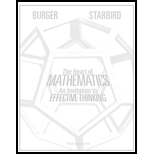
Three coins in a fountain. You pay $5 for three coins to toss in a fountain and see how they land. If you see no heads, then you receive $20. If you see exactly one head, then you receive $5 (the game is a draw), and if you see at least two heads, then you lose. What is the expected value of this game? Is there one single possible outcome whereby you would actually gain or lose the exact amount computed for the expected value? If not, why do we call the expected value, the expected value?
Want to see the full answer?
Check out a sample textbook solution
Chapter 10 Solutions
The Heart of Mathematics: An Invitation to Effective Thinking 4e + WileyPLUS Registration Card
Additional Math Textbook Solutions
Introductory Statistics
A Problem Solving Approach To Mathematics For Elementary School Teachers (13th Edition)
Elementary Statistics: Picturing the World (7th Edition)
Calculus: Early Transcendentals (2nd Edition)
Thinking Mathematically (6th Edition)
A First Course in Probability (10th Edition)
- 3. f(7) 3. Find the domain of each of the following functions. 1 1. f(x)=2-6x+8 2. f(x)=√√7-x 4. A manufacturer has a monthly fixed cost of $40,000 and a production cost of $8 for each unit produced. The product sells for $12 per unit.arrow_forward7. Evaluate the following limits and justify each step. (a) lim (3x²+2x+1) 1 x²+4x-12 (b) lim 1 2 x² - 2x t-√√3t+4 (c) lim t-0 4-t x²-6x+5 (d) lim (e) lim x 5 x-5 x→2 x²+2x+3 4u+1-3 (f) lim u➡2 u-2 1 (g) lim x-3 2 x 55 x - 7x4 +4 (h) lim xx 5x+2x-1 x+1 (i) lim x²-2x+5 - 7x8+4x7 +5xarrow_forward6. Given the following graph f(x). (-2,2) 2- -5 -3 -2 (-2,-1) -1 (0,1) -2- 1 (3,0) 2 3 4 5 (3,-1) א X Compute each of the following. (a) f(-2) (b) lim f(x) #129 (c) lim f(x) *→12+ (d) lim f(x) 811H (e) f(0) (f) lim f(x) 8011 (m) Is the function continuous at x = -2,0,3? Why or why not? (g) lim f(x) +0x (h) lim f(x) x 0 (i) f(3) (j) lim f(x) x-3- (k) lim f(x) x+3+ (1) lim f(x) #13arrow_forward
- (i) For a given constant a > 0, let an investor's preference be represented by the Gaussian utility function U(w)=1-e-aw² For what range of wealth level w will the investor be non-satiated and risk-averse? Explain your answer. (ii) Give an example of a utility function that exhibits DARA and verify it. (iii) Determine the class of utility functions with relative risk aversion coefficient R(w)= w², w> 0.arrow_forward3. Compute the profit corresponding to 12,000 units. 5. A rectangular box is to have a square base and a volume of 20 ft3. The material for the base costs $0.30 per ft2, the material for the sides cost $0.10 per ft2, and the material for the top costs $0.20 per ft2. Letting a denote the length of one side of the base, find a function in the variable x giving the cost of constructing the box. 6. Given the following graph f(x).arrow_forward8. On what intervals, each function continuous? (a) f(x) = 3x11 + 4x²+1 3x²+5x-1 (b) g(x) = x²-4 X, x < 1, QTs the function f(x) continuous at = 1? Use the definition of continuity to justifyarrow_forward
- review problem please help!arrow_forwardSara (a 23 year old college graduate) is starting her first career. She met with a financial planner and has determined that she wants $1,000,000 when she retires at the age of 63. She has found an annuity that pays 4.25%, compounded quarterly. What will she need to save each month, if Sara waits 20 years to start saving? N: P/Y: I%: C/Y: PMT: FV: End or Begin $4158.98 $4,115.26 $2645.83 $6,707.40arrow_forwardSara (a 23 year old college graduate) is starting her first career. She met with a financial planner and has determined that she wants $1,000,000 when she retires at the age of 63. She has found an annuity that pays 4.25%, compounded quarterly. What will she need to save each month, if a) Sara begins saving now? N: P/Y: I%: C/Y: PMT: FV: End or Begin $1,323.80 $1,376.59 $794.74 $1,000,000arrow_forward
 College AlgebraAlgebraISBN:9781305115545Author:James Stewart, Lothar Redlin, Saleem WatsonPublisher:Cengage Learning
College AlgebraAlgebraISBN:9781305115545Author:James Stewart, Lothar Redlin, Saleem WatsonPublisher:Cengage Learning
 Algebra and Trigonometry (MindTap Course List)AlgebraISBN:9781305071742Author:James Stewart, Lothar Redlin, Saleem WatsonPublisher:Cengage Learning
Algebra and Trigonometry (MindTap Course List)AlgebraISBN:9781305071742Author:James Stewart, Lothar Redlin, Saleem WatsonPublisher:Cengage Learning Holt Mcdougal Larson Pre-algebra: Student Edition...AlgebraISBN:9780547587776Author:HOLT MCDOUGALPublisher:HOLT MCDOUGAL
Holt Mcdougal Larson Pre-algebra: Student Edition...AlgebraISBN:9780547587776Author:HOLT MCDOUGALPublisher:HOLT MCDOUGAL



